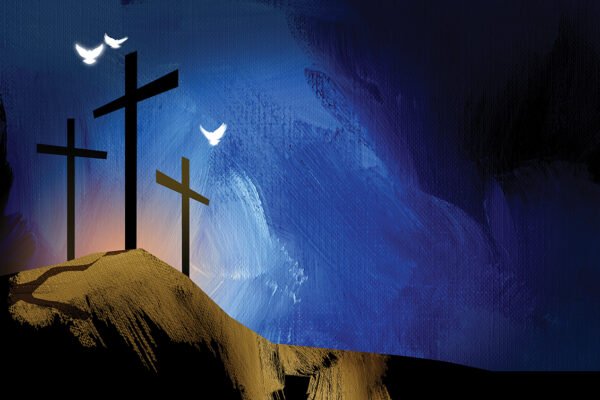Many accurate prophecies in Scripture are in the book of Daniel. Though it is by no means the only repository of prophecies, it is possibly unparalleled in references to historical events and the coming of Jesus. This book adds another layer of proof to the veracity of the Bible.
Daniel is sometimes hard to follow because of the way the book was recorded. The first six chapters are considered by most Bible scholars as the narrative section where everything was recorded chronologically. But starting in the seventh chapter, the writing is largely prophetic. The first six chapters contain prophecies, but the last six are bristling with end-time predictions, and they are not chronological.
Our focus here is the seventh chapter. It occurred in the first year of Belshazzar’s reign, several years prior to the events of the fifth chapter, when Belshazzar was judged with the writing on the wall.
Chapter 7 occurred approximately fourteen years before Daniel’s experience in the lions’ den under Darius, recorded in the sixth chapter.
Furthermore, the vision of chapter 7 corresponds to the
vision of chapter 2 that was given to Nebuchadnezzar! The vision to Belshazzar in chapter 7 is more detailed. Where the vision of the great statue in chapter 2 was more dispassionate, this chapter is a moral interpretation of the same kingdoms.
Daniel received the vision as he lay on his bed, possibly meaning it was a waking dream. He received it from the four winds, as it rushed like a mighty tempest on the sea. The vision was more than regional, as it relates to the entire world. Daniel saw four beasts, and the operative words he used to describe them were like and resembling, as they were symbols of kingdoms to come.
The beasts
Beast one: a lion with eagle’s wings (v. 4)
Both Nebuchadnezzar and Babylon are indicated here. Analogous to the golden head of the statue in chapter 2, this showed royal preeminence, represented by the lion and eagle, first among beasts and fowl.
The creature’s feathers/wings were plucked, and it stood upright and was given a man’s mind. The scripture says that it would be given the heart of a beast and not of a man (4:16). When Nebuchadnezzar returned to his senses, he was given the dignity of man again.
Beast two: a bear (v. 5)
The bear was considered second in majesty to the lion. It “was raised up on one side” as the bear got up from slumber ready to attack. Remember again that this is the two-sided kingdom (as the arms of the statue in chapter 2) and that the side that raised itself actively first is likely the Medes, followed in concert by the Persians.
The three ribs were the result of a recent meal, which included Lydia, Babylon, and Egypt. They were told to “devour much meat,” which was true of Medo-Persia’s voracious conquests.
Beast three: leopard with four heads and four wings (v. 6)
Though the leopard, or panther, is not as royal as the lion or as strong as the bear, it was more agile in attacking than either of them.
Wings again represent speed, and they spread to the four corners of the earth (four wings), representing Alexander the Great and Greece. Remember, it is said that he sat down and wept because there were no more worlds left to conquer (“dominion”).
“Four heads” represent the division of the kingdom into four of Alexander’s generals after Alexander’s death: Cassander, Lysimachus, Ptolemy, and Seleucus. Here again is evidence for the great accuracy of Bible prophecy. Nebuchadnezzar’s dream showed the two thighs representing Greece, and here there are four heads. We know that the immediate division was into four sections, but intrigue continued until only two divisions resulted, under Ptolemy and Seleucus.
Beast four: no name, as if an animal could not represent it (v. 7)
This beast was a monstrosity; it was Rome. It had ten horns (as ten toes were stomped in Nebuchadnezzar’s statue), representing totality as well as the number of kings.
Beast four of Daniel’s prophecy resembled no known animal. It was the one with iron teeth. It trampled everything and was different than all of the others before it. Rome was the amalgamation of the three previous kingdoms.
In Revelation 13:2, all four beasts are combined in a one-world kingdom vision, which represents the might and political power of the godless world, seeking always to advance its agenda over God’s.
The meaning
What does God show us in this vision?
The certainty of predicted events. When Daniel saw this vision, only the first kingdom had begun, and the rest must have seemed confusing. Yet surely each event came to pass just as it had been predicted.
Just so, one day the mouthy “horn” of Daniel 7:8 (the Antichrist of Revelation 13) and the final trampling kingdom (spiritual Rome) will be overwhelmed and surrendered to the flames of judgment, and God will set up His own final kingdom. This was certified when Jesus came and was seated on the throne of David, ushering in a kingdom that will never end.
The saints of God will reign. Jesus said in the last chapter of the Bible, “Behold, I am coming quickly, and My reward is with Me, to render to every man according to what he has done” (Revelation 22:12).
These four kingdoms will be replaced by one of a different character. The kingdoms of the world, represented by these four, are characterized by sin and suffering, if not avarice and greed. History has been written in tears and blood.
One day, the Prince of Peace will reign, and all nations will call Him blessed. This is the message of Daniel 7:9-28. The Ancient of Days, God the Father, will set up His throne and invite Jesus to take sovereign control and dominion, and His kingdom “will not pass away” (vv. 14, 27). And so, in chapter 2, the stone, “cut out without hands,” destroyed the statue (v. 34). God previously delivered the first messianic prophecy of the Bible in Genesis 3:15 and said to Satan that Jesus “shall bruise you on the head, and you shall bruise him on the heel.” The bruise on the heel was temporary in Christ’s crucifixion (Isaiah 53:3, 4). The bruise on the head (which means “crush,” as in Romans 16:20) is mortal. The kingdom of Rome is still thrashing around like a wounded snake, but it is dying.
Romans 8:18 says, “For I consider that the sufferings of this present time are not worthy to be compared with the glory that is to be revealed to us.”
This prophecy gives us hope! The Bible is the only sacred text on earth that is entirely predicated on predictive prophecy. It rises and falls on whether its prophecies are true. Only God could predict and deliver His messages without error. All others would soon be shown as charlatans. Strengthen your faith by reading the many regular prophecies in the Bible, plus the hundreds of Messianic prophecies that were accurately fulfilled.
Also, because all these prophecies given through the prophets were fulfilled with astounding accuracy, those predicted for future days through Daniel and the many other Old Testament prophets will come to pass as well. We can trust the words God has delivered. As Daniel, we may be overwhelmed with the ferocity of the visions, and we might be confused as to their meaning, but we can rest in the lovingkindness of God.
The wicked schemes of the devil and the strategies of this rebellious world will be rendered powerless. And God will bring His people home.







